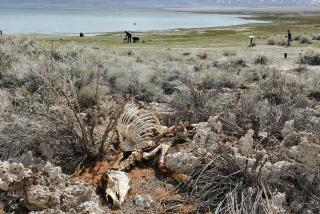Brutal Winter Takes Toll on Flourishing Deer Population in Midwest
- Share via
WAUSAU, Wis. — It was March in the Upper Peninsula of Michigan. Ten deer, weakened from weeks of bitter cold and belly-deep snow, finally found refuge on some railroad tracks.
But their safety was short-lived. Stressed from one of the most severe winters of the century, the deer refused to jump back into the snow and were run down by a train.
The deer were among hundreds of thousands of whitetails that experts estimate died last winter in the upper Midwest as nature compensated for years of mild winters that have allowed deer populations to flourish.
“There is no question that this was a great winter to be a fox, owl and coyote,” said Ed Langenau, a big-game specialist for the Michigan Department of Natural Resources.
“We have had starvation reports beginning in February, which is very unusual. It was a very good year to be a predator in the north country because of the large number of carcasses on the ground,” he said.
In Michigan, game managers are doing extensive dead-deer searches for the first time since spring 1980 to verify projections that 200,000 died during the winter, primarily in the Upper Peninsula. The figure is more than triple the estimate for the winter of 1994-95.
In parts of northern Wisconsin, the winter severity index--the gauge by which the state has measured the impact of winter on deer survival for 35 years--reached all-time record numbers, leading to estimates that 150,000 deer perished.
On a scale of one to 10 with 10 being the worst, the winter for deer in Minnesota was a 10 and probably claimed up to 40% of last year’s fawn crop and 5% to 15% of the adults in the northern regions of the state, said Jay McAninch, a deer research biologist for the Minnesota Department of Natural Resources.
The Minnesota Legislature ordered the department to begin feeding the herd in February. The agency spent $1 million and fed 5,100 tons of feed pellets. Ironically, the deer were being spared for a later fate.
“Largely, it was viewed as saving the deer so [hunters] could shoot them later,” said Ed Boggess, the department’s wildlife resource manager.
By early May in northern Wisconsin, some sportsmen hoping to ward off deer starvation had set out nearly 400 tons of feed--some of it potatoes in 100-pound sacks hauled into the woods on snowmobiles.
Farther east, deer biologists in Pennsylvania, New York and Maine reported their whitetail herds were spared undue hardship because a January thaw and some rains melted heavier snow cover that had threatened starvation.
“Everything came through with flying colors,” said Bill Palmer of the Pennsylvania Game Commission. “We probably lost more turkey than deer.”
While wildlife experts in Wisconsin, Minnesota and Michigan said the winter conditions and winterkill of deer was the most severe since 1978-79, they predicted no wholesale decline in hunting prospects this fall.
In fact, each state intends to continue issuing permits to kill does in many places to further check the growth of the herds.
Kevin Wallenfang, a deer biologist for the Wisconsin Department of Natural Resources, said his agency’s winter severity index suggested at least 150,000 deer would die.
But a month of real hard crust on the snow when deer could browse higher into trees, extensive private feeding of deer and a few days of somewhat mild temperatures at crucial times may have helped reduce that figure.
“Nobody went out and found a herd lying there dead,” he said. “You find them spread out.”
Don Solin, president of the Langlade County Quality Deer Management Assn., a group of about 60 landowners who manage 12,000 acres in northern Wisconsin used for deer hunting, said his group distributed 480 tons of feed, mostly potatoes, to save deer from the long winter.
“We had guys coming up bagging up 100-pound sacks and taking them [to deer] on snowmobiles,” he said. “A lot of people didn’t want to see the deer suffer and were willing to go through the effort.”
Michigan’s Langenau said the past winter in the upper Midwest was rated one of the 10 worst in the last 100 years.
Motorists saw deer literally stuck in snowbanks, he said. Starving deer that lose 25% of their weight and every ounce of body fat become so weak they can’t walk or run from predators like coyotes.
The deer caught on the train tracks were so stressed that their reactions and senses were altered, causing them to run in fear down the tracks rather than respond to the danger of the train.
“The suffering these animals go through in winter is a lot worse than a well-placed .30-06 [rifle] round,” Langenau said. “Some winter mortality is good. But when you have massive losses, it is not good for the herd and not good for the habitat.”
More to Read
Sign up for Essential California
The most important California stories and recommendations in your inbox every morning.
You may occasionally receive promotional content from the Los Angeles Times.













